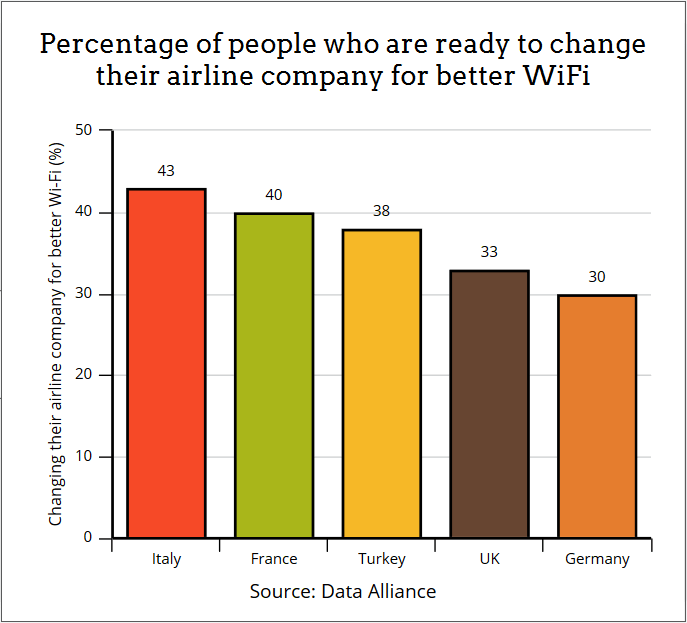





Copyright © Urban Muse Writer · All Rights reserved


In-flight Wi-Fi Explained
In-flight Wi-Fi seems to be the latest fad these days. Who would have thought about that a decade ago? But the reality is that we've grown attached to our Internet-connected devices. These days we can't even imagine commuting to work without opening our Facebook accounts, or watching the latest popular video clips on YouTube.
Airline companies are aware of this, and some of them try to capitalize on it. In fact, just watched a short clip in which one of the big airline businesses was advertising its free in-flight Wi-Fi service. It's all good until you read the fine print, right? Because that company was only offering the first 2 MB of data for free. What could you possibly do with only 2 MB? Load a picture? Or maybe check your email, hoping that nobody has sent you an email attachment? We are living in a crazy world, I'm telling you!
Anyway, enough with the rants. About 60% of passengers consider in-flight Wi-Fi to be a necessity these days. The percentage is even bigger when it comes to parents traveling with children (close to 70%) or people that use planes for long-haul flights (over 80%). And believe it or not, many people would even change their preferred airline company with one that offers a better Wi-Fi service! Here's a graph produced by Data Alliance which shows the top 5 countries where this change would take place.

Most aircrafts will be fitted with new technologies that makes in-flight wireless Internet access possible this year, and manufacturers hope to finish the entire process by 2020.
But how does high-altitude Wi-Fi work in the first place? The first method uses mobile broadband towers that broadcast signal to several specially designed Wi-Fi antennas, which are usually mounted at the bottom of the aircraft. The system works fine, provided that the network of towers is dense enough, and the plane doesn't fly across large bodies of water.
Of course, if the opposite happens, or if the plane passes over fully isolated areas (jungles, deserts, and so on) connectivity may be a problem.
The much better option is to use satellite-based technologies. In this scenario, the plane is constantly connected to a satellite that orbits about 22 miles above the surface of the Earth. A pair of receivers and transmitters that are mounted on the plane exchange data with the satellite, and passengers have Internet access due to a specially built Wi-Fi router.
It's ironic, but things were working a bit better a decade ago, despite the fact that in-flight Wi-Fi was in its infancy. The explanation is simple, though; nowadays, people expect to have fast Internet connections during their flights - similar with what they're getting in their homes!
Back in 2008, a typical 3Mbps in-flight connection was good enough for most people's needs. But now, everyone wants to stream the latest Netflix movies while flying, and we aren't there yet. These days, even the most modern satellite connections provide Internet speeds that barely exceed 10 Mbps.
As you can imagine, access to all this technology is quite expensive. The additional hardware equipment weighs more, and this increases fuel consumption as well. Some companies have decided to absorb some of the costs, offering their passengers the first 10 MB of data transfer for free.
It's a good start, and it looks like things will be even better in the future. The Europeans have started to work at EAN (European Aviation Network), a system that combines the best of both worlds: high-capacity Wi-Fi satellites and efficient ground towers. The system, which is backed by Inmarsat and Deutsche Telekom, will be implemented later this year, and it should become the standard, at least for European aircrafts, by 2020.
The US has a similar project - Gogo 2Ku - which has already been launched, but it has been criticized for its slow upload / download speeds. The good news is that a soon-to-be-launched system upgrade is supposed to increase data transfer speed to 70 Mbps.
But how does high-altitude Wi-Fi work in the first place? The first method uses mobile broadband towers that broadcast signal to several specially designed Wi-Fi antennas, which are usually mounted at the bottom of the aircraft. The system works fine, provided that the network of towers is dense enough, and the plane doesn't fly across large bodies of water.
Of course, if the opposite happens, or if the plane passes over fully isolated areas (jungles, deserts, and so on) connectivity may be a problem.
The much better option is to use satellite-based technologies. In this scenario, the plane is constantly connected to a satellite that orbits about 22 miles above the surface of the Earth. A pair of receivers and transmitters that are mounted on the plane exchange data with the satellite, and passengers have Internet access due to a specially built Wi-Fi router.
It's ironic, but things were working a bit better a decade ago, despite the fact that in-flight Wi-Fi was in its infancy. The explanation is simple, though; nowadays, people expect to have fast Internet connections during their flights - similar with what they're getting in their homes!
Back in 2008, a typical 3Mbps in-flight connection was good enough for most people's needs. But now, everyone wants to stream the latest Netflix movies while flying, and we aren't there yet. These days, even the most modern satellite connections provide Internet speeds that barely exceed 10 Mbps.
As you can imagine, access to all this technology is quite expensive. The additional hardware equipment weighs more, and this increases fuel consumption as well. Some companies have decided to absorb some of the costs, offering their passengers the first 10 MB of data transfer for free.
It's a good start, and it looks like things will be even better in the future. The Europeans have started to work at EAN (European Aviation Network), a system that combines the best of both worlds: high-capacity Wi-Fi satellites and efficient ground towers. The system, which is backed by Inmarsat and Deutsche Telekom, will be implemented later this year, and it should become the standard, at least for European aircrafts, by 2020.
The US has a similar project - Gogo 2Ku - which has already been launched, but it has been criticized for its slow upload / download speeds. The good news is that a soon-to-be-launched system upgrade is supposed to increase data transfer speed to 70 Mbps.